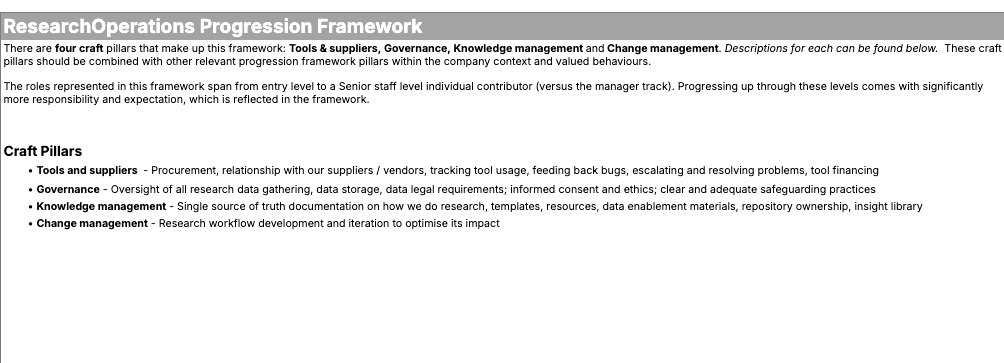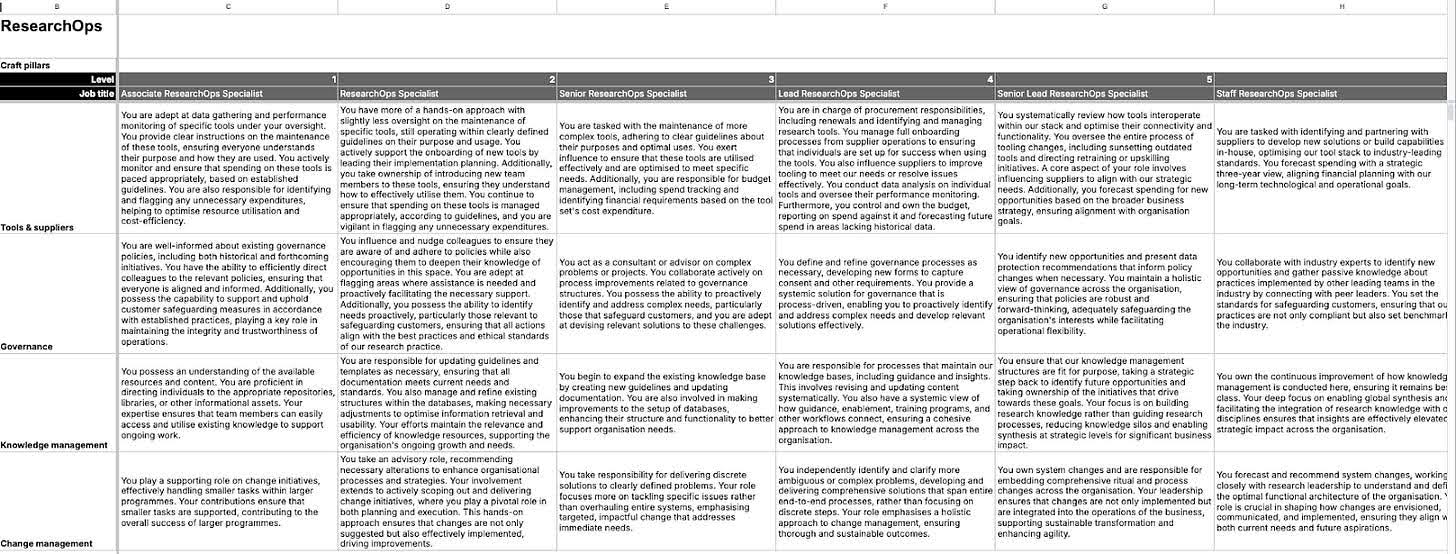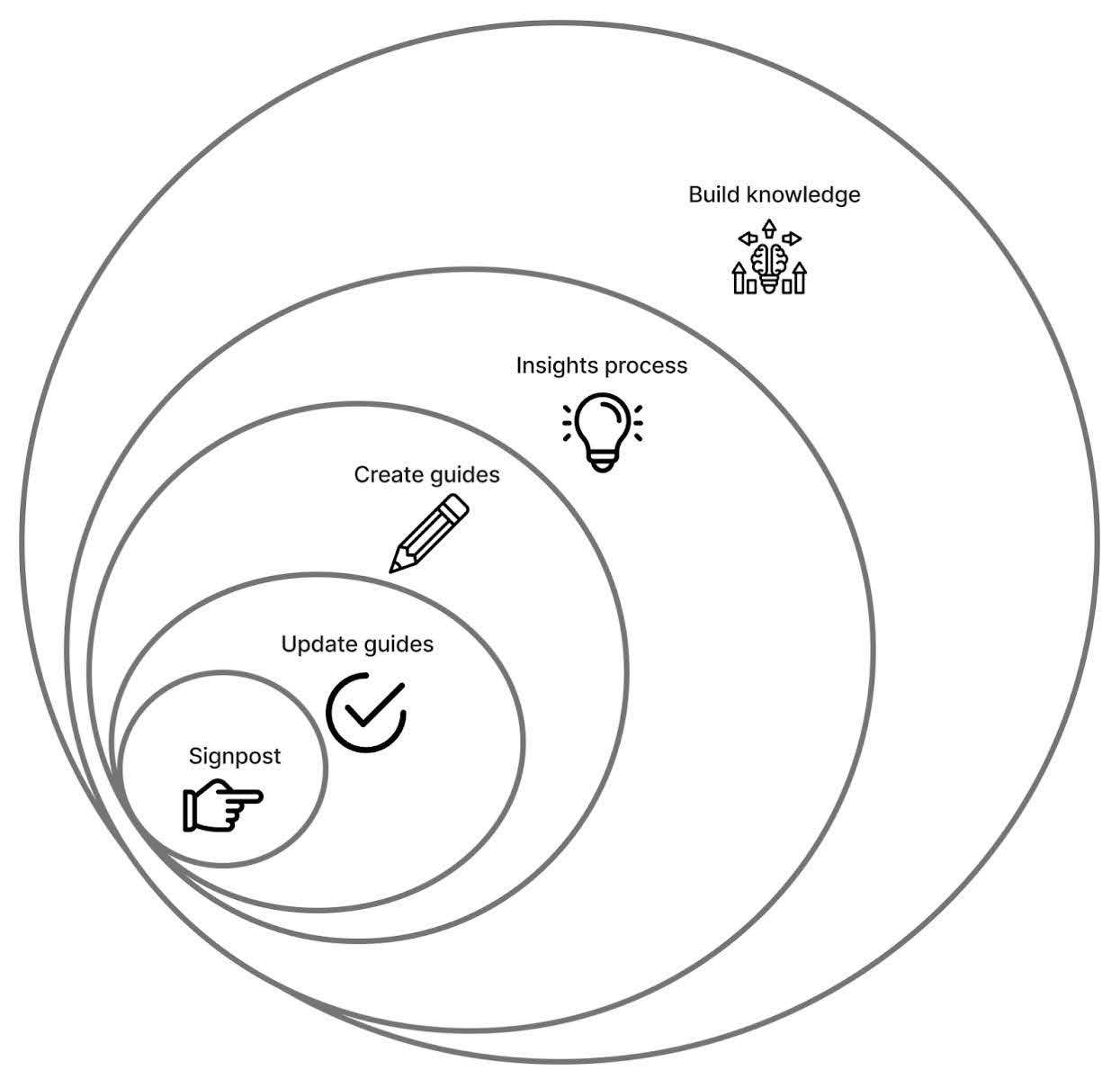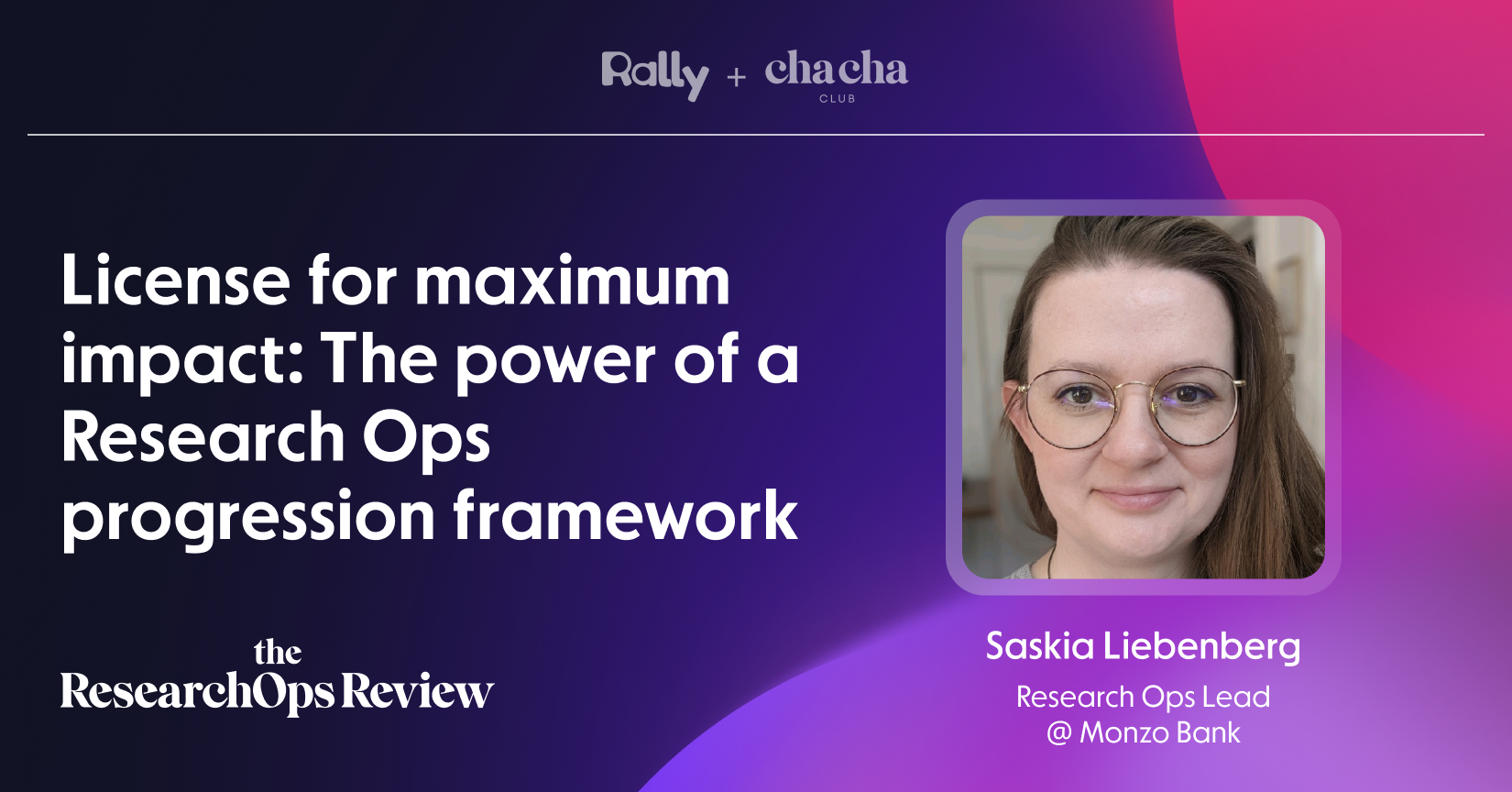License for maximum impact: The power of a Research Ops progression framework
A few years ago, the research director at one of my previous jobs put me up for promotion. While the effort had been supported by our design counterparts, the engineering and data science managers couldn’t wrap their heads around the function of Research Ops at any level, never mind the more senior-level role my manager had proposed I move into. The only career progression framework these managers had to calibrate my performance against was the one they used for researchers, and it just didn’t transfer across: they’d never seen me delivering insights or impacting the product roadmap.
In short, we lacked a common language to help decision makers understand how to think about Research Ops and how to evaluate role performance and advancement across the company’s seniority structure. Needless to say, I didn’t get that promotion. And even worse, the decision makers were left believing that ResearchOps was a low-impact function.
I didn’t want to experience this again — ever. So I was delighted when, in the summer of 2024, my manager made it a priority for us to develop a career progression framework specific to ResearchOps. What surprised me, though, was that along with helping me build a case for promotion, an even bigger benefit emerged: setting a baseline for what Research Ops is, the impact my manager and I expect the function to have, and how we see the future of Research Ops at the company.
Shape context and facilitate visibility
Like many people in Research Ops (or even DesignOps), I’ve either been the first or the only person in the company in the role. It’s exciting, fun, and so rewarding to forge a new path and create thoughtful operational infrastructures that have a meaningful impact…except when it comes to performance review time and promotion cases. Then it can feel like a disadvantage to be “the most niche employee in the company!”, as a friend puts it.
When the role is new or niche, there’s no mental model or context for what good Research Ops means, because, as is often the case, there isn’t a career progression framework yet. You might call this a career ladder, performance matrix, skills framework, job architecture, or level document. In short, it’s a tool managers use to evaluate what success in a role looks like, and how to level their team members. And, of course, it’s also used to evaluate whether someone should be promoted (or not), which makes it an important asset for employee growth, especially when the role is niche.
That said, it can seem quite challenging to prioritize the development of a framework that outlines the skills, scope, and behavioral expectations across anticipated levels of seniority when there’s just one person in the role. But if you make the time for it, ‘future you’ will have more productive performance reviews — and importantly, the effort will crystallize the entire ResearchOps strategy and set you up for success through impact across the organization; in addition to enabling more productive performance reviews.
Build a solid foundation
Luckily, when we started this endeavor, we didn’t have to work with an entirely blank canvas. We already had an overarching architecture that defined scope and impact for each job level across the company, and we looked at the researchers’ progression framework as a reference point (as Research Ops was a specialism within the research team). But for the Research Ops-specific framework to be meaningful, it was important to explicitly call out several craft pillars that are unique to the craft of Research Ops.
The framework
In establishing these craft pillars, a key concept emerged: Research Ops is fundamentally a strategic, transformative practice rather than an administrative or support practice. As a result, we looked for fundamental capabilities relevant to strategic, transformative outcomes (see Figure 1). Here are the four craft pillars and what each one encompasses:
- Tools and suppliers. Management of vendor and supplier relationships; tracking tool usage; procuring, implementing and optimizing the tool stack; escalating and resolving problems; and tool financing.
- Governance. Oversight of research data gathering, storage and access frameworks; ensuring compliance with regulatory and legal requirements; informed consent practices and ethics; clear and adequate safeguarding practices.
- Knowledge management. Single source of truth documentation for what we learn from the research and for how research is done; ranging from how templates, resources, and enablement materials are created and used to how the data repositories and insight library are structured, maintained, and accessed.
- Change management. Workflow development and iteration for impact optimization. Includes needs assessment, solution design, and embedding change through coaching and enablement.

Once we defined the craft pillars, we set out to describe what it meant in practice to embody each pillar across different levels of experience and seniority in the framework (see Figure 2). The exercise showed us how straightforward — and even fun! — it could be to create structure for the function; and it’s proven to be so worth the effort.

The scalable craft pillars
The progression framework’s craft pillars are specific to Research Ops, yet broad enough that they are relevant in multiple contexts. So the pillars can be adapted to suit a variety of operating models and sizes of teams, we purposefully focused on categories that are agnostic to Research Ops specialisms (like participant recruitment) but cover key skills relevant across these specialisms.
This flexibility is also reflected in the seniority levels represented in the framework. As the levels advance in seniority, each pillar expands to areas of craft with more complexity, ambiguity, scope size, and a wider circle of influence (see Figure 3).

For example, the knowledge management responsibility shifts from signposting and maintaining guidance in earlier levels; to creating, updating, and expanding the guidance in the middle levels; to processing knowledge and enabling research insights development in the more senior levels.
Bonus: Use the framework for scoping
In working out what the craft pillars were and how they scaled across different levels, my director and I were able to tightly align on and outline the remit and scope of the Research Ops function as a whole. For example, we could demonstrate in very practical terms how a more experienced Research Ops person would approach tooling (looking at the whole system and how the tool stack interoperates with a view to transforming ways of working), versus the approach of someone in a more junior station (overseeing usage of a standalone tool to find improvements and optimization).
I now refer to the framework during planning cycles as a sort of scoping tool. And grounding myself, at my level, within the craft pillars has helped me home in on the projects that will truly transform how research is done, in line with the overall research strategy, directly correlating to the impact expected at my level of seniority. It’s given me the mandate to go for the bigger system changes that have a transformational effect rather than focusing on incremental improvements.
For example, from ongoing feedback and monitoring, I knew that our participant recruitment workflow needed attention. Now, there’s a wealth of options available that would offer improvements, from standardizing screener surveys to overhauling the recruitment tool stack. Benchmarking myself in my current position against the next level up in the progression framework sharpened conversations I had with leadership about what Research Ops should be delivering in this area, and how.
At my current level, I should be aiming to create impact on systemic transformation, overseeing the complete research recruitment process and how it interoperates with other tools, data integrations, and research workflows. This clarity inspired me to produce a holistic review of the entire recruitment workflow with the goal of transforming the process completely. As a result, I onboarded Rally, a bespoke research CRM platform, which integrated with our customer database and other tools. The new system is intuitive to use, streamlined, and much more effective. And the load on Research Ops to troubleshoot and provide ad hoc support has lightened significantly — which, in turn, gives me more time for strategic work.
Along with scoping support, the career progression framework offers even more: I’ve benefited from referring to it when planning my development goals and when gathering feedback on my performance from my peers — and it has positively sped up discussions about and plans for hiring my first teammate.
Create impact
The Research Ops Progression Framework sets a high bar, certainly, but it’s flexible enough to be relevant to a range of scenarios and operating models, and you can even expand it to include additional pillars that align with your company’s values. For example, the current version of the framework includes citizenship and behavior pillars, which support the craft pillars and integrate with other discipline frameworks within my organization (see Figure 4).
No matter your organizational context, values, and team mission, the Research Ops Progression Framework will help you to better define your role, clarify goals and impact, and find surefootedness along your professional growth path. Use it as a starting point, adapt it to suit your needs and circumstances, embrace it fully — and give yourself the license to make an impact.
Edited by Kate Towsey and Katel LeDu.
👉 The ResearchOps Review is the publication arm of the Cha Cha Club – a members' club for ResearchOps professionals. Subscribe for smart thinking and sharp writing, all laser-focused on Research Ops.
Rally’s Research Ops Platform enables you to do better research in less time. Find out how you can use Rally to empower your teams to talk to their users, without disjointed tooling and spreadsheets. Explore Rally now by setting up a demo.

